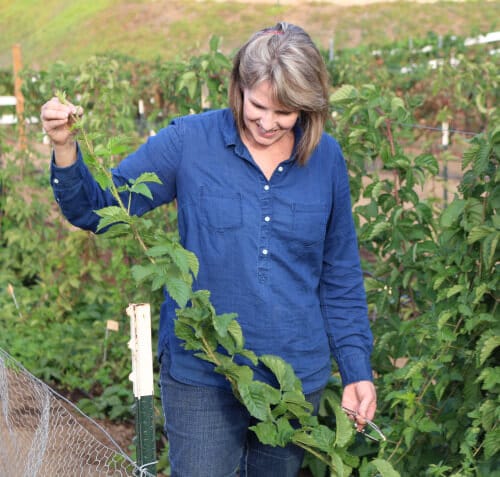Growing Your Own Boysenberries
Many years ago, my dad brought home a boysenberry vine to my mom. She selected a special spot on the shady side of the house and planted it there. What a spectacular fail. We never gleaned any boysenberries from that vine and eventually it simply gave up, never to be seen again.
Failure has such a way of sticking with me. It made me really dig in, to learn what a boysenberry vine loves and what it hates. I learned to focus on 5 things when it comes to growing boysenberries: soil, sun, water, trellis and pests. Rudy’s Original Heritage Boysenberry vines are very hardy. If you focus on these things, you will reap a bountiful harvest of boysenberries at the beginning of every summer.

Boysenberries LOVE
- A sandy loam soil, easy to shovel with lots of organic matter in it.
- Slightly acidic soil, with a PH between 5.8 – 6.5.
- Rich soil, I use well composted chicken manure to build my soil. Apply and till in 10 lbs. per vine in the spring. (substitute 15 lbs. composted steer manure)
- Sunshine. Boysenberries love sunshine and the berries get sweeter as the weather gets warmer.
- Frequent watering. Boysenberries love moist soil. They were born in a creek bed in Napa, where my grandfather worked. We use drip irrigation to assure our vines get just the right amount of moisture, not too much, not too little and only at the base of the plant. Cover the soil with mulch to help hold in moisture and aid in weed control.
- Trellis. Our Rudy’s Original Heritage Boysenberries are a trailing variety. Canes can get 20′ long. A strong trellis is required to give the boysenberries good exposure to sun and make berry picking easy.
- About pests. We’re not the only ones that love boysenberries. Birds, deer, squirrels, and other critters love boysenberries too. You may need to protect your vines and berries with a fence and bird net.
Boysenberries HATE
- Poorly drained clay soil, difficult to shovel and lacking organic matter.
- Alkaline soil. You can use a pool pH test strip in a cup of water mixed with soil to test it. Alkaline pH can be corrected over time using elemental sulfur.
- Undeveloped soil. No humus, no life. Boysenberry vines will struggle to grow and bear fruit in poor soil.
- Shade. Well, some shade can be good, but full shade is not. Lack of sunshine leads to an unhealthy vine, susceptible to disease.
- Watering extremes – too much or too little watering will lead to an early demise of your boysenberry vine. Look for signs of over watering such as constantly muddy soil at the base of the plant and yellowing leaves. Watch for dry cracking soil, indicating your vines are not getting enough water. One additional point about watering, wet leaves lead to mold and mildew. Sprinklers are not a good choice for watering boysenberry vines.
- Unstructured growing areas make it much more difficult to care for your vines. Raise your vines up off the ground to maintain them.
- Our family and friends have grown boysenberries in different parts of the Southwest, California, Oregon and Washington. Different locals seem to have an over abundance of different kinds of pests. Shape your pest avoidance strategy to your particular need.
